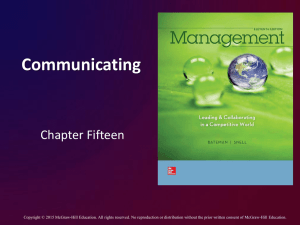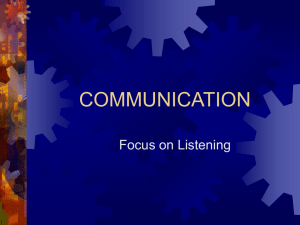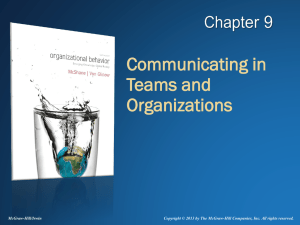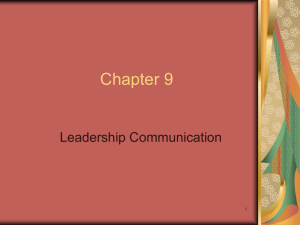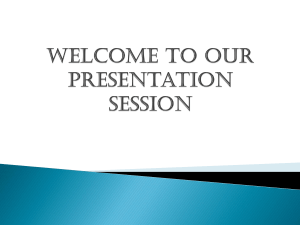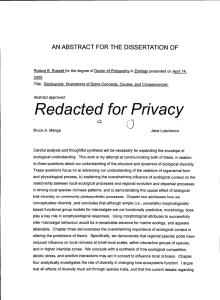Communications
advertisement
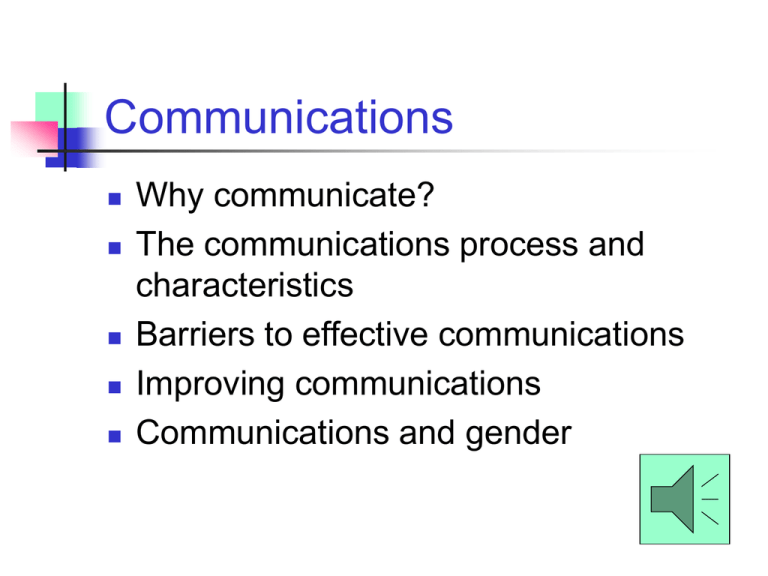
Communications Why communicate? The communications process and characteristics Barriers to effective communications Improving communications Communications and gender Why Communicate? To convey information To receive information To determine what information needs to be sent or obtained To gain acceptance for you or your ideas To motivate other people To maintain relationships with coworkers, clients, etc. To establish trust To keep people involved in a project To produce action or change To understand the wants and needs of your stakeholders To express your emotions or feelings The Communications Process Sender Noise Barriers Message Barriers Feedback Receiver Types of Communications Forms of communication Verbal Written Non-verbal To Whom Immediate coworkers Supervisor / subordinates Others within own organization Customers and clients Suppliers / vendors Communications Channels Face-to-face Telephone Grapevine E-mail Memos, letters Formal reports Channel Richness Channel Richness A channel’s ability to transmit information, including the ability to handle multiple cues simultaneously, encourage feedback, and focus personally on the receiver. Why Is It Important? More cues (i.e., words, tone of voice, and non-verbals) allow more information to be transmitted Feedback ensures that listener has opportunity to obtain additional information or clarify any uncertainties Personal focus permits customizing message and encourages listener attention Channel Richness: Specific Channels High Channel Richness Phone call Memos, Letters Low Channel Richness Face to face E-mail, voicemail Formal Report Non-Verbal Communications Voice Appearance Face and eyes Posture and movement Personal space and distance Time Physical environment Rumors and the Grapevine The informal network About 75% accuracy Purpose Reduce anxiety Make sense of ambiguity Organizing coalitions Signal status Managing rumors, gossip and the grapevine Communicate openly -- the good and the bad Deliberate rumors ?? Barriers to Communications Information overload Noise Language Filtering Selective perception Defensiveness Information Overload Multiple communications Phone and voicemail Email Pager Cellphone Reports and memos What price peace and quiet ?? Noise Physical noise and distractions Environment (cold, heat, dust) Preoccupations Language Issues Actual language Accents, etc. Volume and speed Jargon Filtering Sending on the news you think your audience wants to hear Impression management What happens to the messenger bringing bad news…... Selective Perception Stereotypes Halo Effect Projection Primacy and Recency Effects Perceptual Readiness Perceptual Defense Attribution Defensiveness A response to perceived threat or criticism What is it? Personal attacks Sarcasm Questioning motives Supportive and Defensive Climates DEFENSIVE Evaluation Control Strategy Neutrality Superiority Certainty SUPPORTIVE Description Problem Orientation Spontaneity Empathy Equality Provisionalism The Three Hardest Things to Say I Was Wrong I Don’t Know I Need Help Improving Communications Listening Openness Feedback Trust The Levels of Listening Level 1: Unrelated Response Level 2: Tangential Response Level 3: “I had a bad accident yesterday, but nobody was hurt” Furthering Response Level 4: Feeling Response “Did you hear that Chuck and Mary are getting a divorce?” “Cars are a pain; my air is out.” “Were you on Nonconnah when it happened?” “I know you must be relieved to be safe” Listening Guides for Display at the Workplace Stop talking. You cannot listen if you are talking ! Put the talker at ease. Show the talker that you want to listen. Remove distractions. Empathize. See the situation from the other person’s point of view. Be patient. Hold your temper. Go easy with arguments and criticisms. When you argue, even if you win, you lose. Ask questions to show interest and encourage response. Stop Talking. This is both first and last, because all other guides depend on it. How to Listen Nature gave people two ears but only one tongue, which is a gentle guide that they should listen more than they talk. Listening requires two ears, one for meaning and one for feeling. Decision makers who do not listen have less information for making sound decisions. Giving Effective Feedback STRENGTHS Descriptive Feelings evoked Specific Controllable Timely Effect Positive and negative Help WEAKNESSES Evaluative Do it indifferently General Uncontrollable Late Analyze Negative only Punish Receiving Effective Feedback STRENGTHS Elicit Listen Check Clarify Ask others WEAKNESSES Wait Wonder Assume Justify Discount The Three Elements of Trust What Encourages the Development of Trust? Correspondence between word and deed Demonstrations of concern for others’ well-being and needs Willingness to see the other person’s point of view Demonstrated skills and abilities - showing that you can be counted on to accomplish the job Rewards for openness and disagreement No reprisals for speaking your mind Freely expressing your opinion - but with tact Not being afraid to show your emotions Honesty and fairness in business dealings Communications and Gender Are the differences genetic or learned? Does it matter? Typical patterns: this doesn’t apply to all women or all men Women Rapport Expressive Supportive Tentative Initiate and maintain Men Report Instrumental Advising Certain Control
